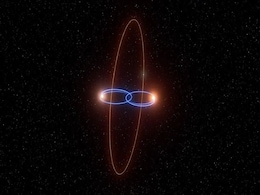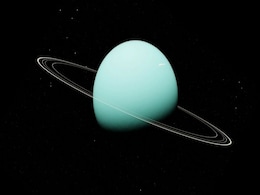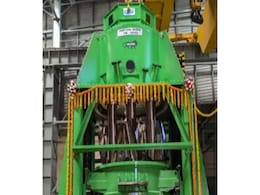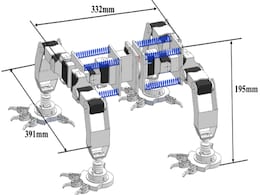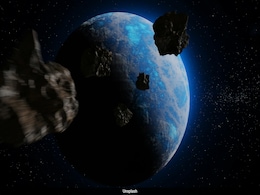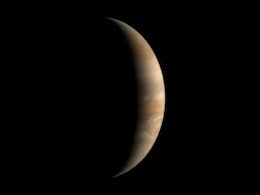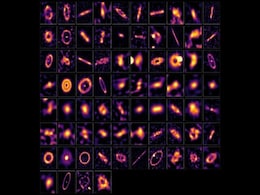Planetary System
- All
- News
- Videos
-

Bizzare 'Failed Star' Planet Orbiting Double Star System in Milky Way Discovered by Researchers
- Thursday April 17, 2025
- Written by Gadgets 360 Staff
Astronomers have discovered an exoplanet 90 degrees tilted around a special pair of eclipsing brown dwarfs. This uncommon "polar planet" challenges accepted wisdom on planet creation by presenting new insights on the dynamics of binary stars and the range of Milky Way planetary orbits.
-
 www.gadgets360.com
www.gadgets360.com
-

Scientists Finally Discover How Long a Day Lasts on Uranus
- Saturday April 12, 2025
- Written by Gadgets 360 Staff
Astronomers confirm Uranus’ rotation period using internal oscillation modeling for the first time. On Uranus, a day just lasts far longer. More precise rotational time observations of the gas giant should enable scientists to plan visits to investigate it. Unlike on Mars and Earth, savage windstorms make it far more difficult to identify the rot...
-
 www.gadgets360.com
www.gadgets360.com
-

JWST Captures Unseen Details of Exoplanets in HR 8799 and 51 Eridani Systems
- Thursday April 3, 2025
- Written by Gadgets 360 Staff
The James Webb Space Telescope (JWST) has captured groundbreaking images of exoplanets in the HR 8799 and 51 Eridani systems. By modifying its coronagraphs, astronomers allowed more starlight to pass through, revealing clearer planetary details. The study, published in The Astrophysical Journal Letters, highlights the first successful detection of ...
-
 www.gadgets360.com
www.gadgets360.com
-

Mysterious Planetary-Mass Objects May Form in Young Star System Clashes
- Wednesday March 12, 2025
- Written by Gadgets 360 Staff
Recent research challenges traditional views on planetary-mass objects, suggesting they may form through violent interactions between young star systems rather than standard planetary or stellar processes. Simulations indicate these clashes create dense gas filaments that evolve into free-floating objects, often in binary pairs. This discovery expl...
-
 www.gadgets360.com
www.gadgets360.com
-

Primordial Helium-3 May Be Locked in Earth’s Core, Study Finds
- Wednesday March 5, 2025
- Written by Gadgets 360 Staff
Helium-3, an isotope formed during the solar system's birth, may be trapped in Earth's core, a study suggests. Researchers at the University of Tokyo found that helium can mix with iron at extreme heat and pressure, allowing it to remain in Earth's solid core. This discovery could help determine how quickly the planet formed, with a rapid formation...
-
 www.gadgets360.com
www.gadgets360.com
-

Planetary Parade 2025: Rare Photo Captures Earth And 7 Planets For The First Time Ever
- Thursday February 27, 2025
- Science | Edited by Ritu Singh
Experts have claimed it could be the first time all planets including Earth have been captured in a single image.
-
 www.ndtv.com
www.ndtv.com
-

ISRO Unveils World’s Largest 10-Tonne Vertical Mixer for Solid Propellants
- Friday February 21, 2025
- Written by Gadgets 360 Staff
ISRO, in collaboration with CMTI, has developed a 10-tonne vertical planetary mixer, the largest of its kind for solid propellants. The system improves precision, efficiency, and safety in propellant production, which is vital for rocket motors. Weighing 150 tonnes, the mixer successfully passed factory-level tests. It is expected to enhance India...
-
 www.gadgets360.com
www.gadgets360.com
-

7 Planets To Align Next Week, Here's How To Watch This Rare Celestial Event From India
- Friday February 21, 2025
- Science | Edited by Bhavya Sukheja
A rare celestial event is set to occur on February 28, when all planets in our solar system will be visible in the night sky briefly.
-
 www.ndtv.com
www.ndtv.com
-

UCLA Unveils SPLITTER, a Tethered Jumping Robot for Space Exploration
- Thursday February 13, 2025
- Written by Gadgets 360 Staff
Researchers at UCLA’s RoMeLa lab have developed SPLITTER, a robotic system designed for planetary exploration through tethered jumping. The system consists of two quadrupedal robots connected by a tether, allowing efficient movement in low-gravity environments like the Moon and asteroids. Unlike traditional rovers, SPLITTER’s design enables sta...
-
 www.gadgets360.com
www.gadgets360.com
-

A Star With a Planet May Be Racing Through the Galaxy at Record Speed
- Wednesday February 12, 2025
- Written by Gadgets 360 Staff
Astronomers have identified a potential record-breaking exoplanet system moving at 1.2 million mph. Detected through microlensing, the discovery suggests a low-mass star with an orbiting planet is racing through the Milky Way. Data from the Keck Observatory and ESA’s Gaia satellite indicate a high-speed celestial body that may eventually escape t...
-
 www.gadgets360.com
www.gadgets360.com
-

NASA's Juno Detects Io's Most Powerful Volcanic Eruption Yet
- Friday February 7, 2025
- Written by Gadgets 360 Staff
NASA’s Juno spacecraft has recorded the most powerful volcanic eruption on Io, Jupiter’s most volcanic moon. The eruption site, detected on 27 December 2024, is fueled by a massive magma chamber spanning 105,000 square kilometers. The heat energy released is estimated at 80 trillion watts, exceeding Earth’s total power output. The volcanic ac...
-
 www.gadgets360.com
www.gadgets360.com
-

High-Resolution Observations Provide New Insights into Brown Dwarf HD 206893 B
- Friday February 7, 2025
- Written by Gadgets 360 Staff
Astronomers have gained significant insights into brown dwarf HD 206893 B using high-resolution spectroscopy. The study, led by UCSD's Ben Sappey, reveals the object's mass, temperature, and formation details, contributing to brown dwarf research. Located 133 light-years away, HD 206893 B's position within a debris disk invites future investigation...
-
 www.gadgets360.com
www.gadgets360.com
-

This Asteroid Could Hit Earth In 2032, Threatening To Wipe Out A City
- Friday January 31, 2025
- Science | Edited by Nikhil Pandey
NASA has detected an asteroid called 2024 YR4, which has a 1 in 83 chance of impacting Earth in 2032, potentially releasing 8 megatons of energy and devastating a major city, although it's too small to end human civilization.
-
 www.ndtv.com
www.ndtv.com
-

Mysterious Interstellar Object Might Have Shifted Four Planets’ Paths, Study Finds
- Thursday January 30, 2025
- Written by Gadgets 360 Staff
A mysterious interstellar object, estimated to be eight times the mass of Jupiter, may have significantly altered the orbits of Jupiter, Saturn, Uranus, and Neptune billions of years ago. A study suggests that this body passed remarkably close to the Sun, potentially influencing planetary trajectories. Simulations conducted by researchers indicate ...
-
 www.gadgets360.com
www.gadgets360.com
-

Trillions of Comets Found in 74 Alien Star Systems, Unveiling Exocomets and Planetary Belts
- Monday January 27, 2025
- Written by Gadgets 360 Staff
A discovery of trillions of comets in 74 star systems has opened new doors for understanding the role of exocomets in planetary water sources. The planetesimal belts, detected using ALMA and SMA telescopes, offer crucial insights into the evolution of planetary systems and the potential for life-supporting water on distant planets. This research pa...
-
 www.gadgets360.com
www.gadgets360.com
-

Bizzare 'Failed Star' Planet Orbiting Double Star System in Milky Way Discovered by Researchers
- Thursday April 17, 2025
- Written by Gadgets 360 Staff
Astronomers have discovered an exoplanet 90 degrees tilted around a special pair of eclipsing brown dwarfs. This uncommon "polar planet" challenges accepted wisdom on planet creation by presenting new insights on the dynamics of binary stars and the range of Milky Way planetary orbits.
-
 www.gadgets360.com
www.gadgets360.com
-

Scientists Finally Discover How Long a Day Lasts on Uranus
- Saturday April 12, 2025
- Written by Gadgets 360 Staff
Astronomers confirm Uranus’ rotation period using internal oscillation modeling for the first time. On Uranus, a day just lasts far longer. More precise rotational time observations of the gas giant should enable scientists to plan visits to investigate it. Unlike on Mars and Earth, savage windstorms make it far more difficult to identify the rot...
-
 www.gadgets360.com
www.gadgets360.com
-

JWST Captures Unseen Details of Exoplanets in HR 8799 and 51 Eridani Systems
- Thursday April 3, 2025
- Written by Gadgets 360 Staff
The James Webb Space Telescope (JWST) has captured groundbreaking images of exoplanets in the HR 8799 and 51 Eridani systems. By modifying its coronagraphs, astronomers allowed more starlight to pass through, revealing clearer planetary details. The study, published in The Astrophysical Journal Letters, highlights the first successful detection of ...
-
 www.gadgets360.com
www.gadgets360.com
-

Mysterious Planetary-Mass Objects May Form in Young Star System Clashes
- Wednesday March 12, 2025
- Written by Gadgets 360 Staff
Recent research challenges traditional views on planetary-mass objects, suggesting they may form through violent interactions between young star systems rather than standard planetary or stellar processes. Simulations indicate these clashes create dense gas filaments that evolve into free-floating objects, often in binary pairs. This discovery expl...
-
 www.gadgets360.com
www.gadgets360.com
-

Primordial Helium-3 May Be Locked in Earth’s Core, Study Finds
- Wednesday March 5, 2025
- Written by Gadgets 360 Staff
Helium-3, an isotope formed during the solar system's birth, may be trapped in Earth's core, a study suggests. Researchers at the University of Tokyo found that helium can mix with iron at extreme heat and pressure, allowing it to remain in Earth's solid core. This discovery could help determine how quickly the planet formed, with a rapid formation...
-
 www.gadgets360.com
www.gadgets360.com
-

Planetary Parade 2025: Rare Photo Captures Earth And 7 Planets For The First Time Ever
- Thursday February 27, 2025
- Science | Edited by Ritu Singh
Experts have claimed it could be the first time all planets including Earth have been captured in a single image.
-
 www.ndtv.com
www.ndtv.com
-

ISRO Unveils World’s Largest 10-Tonne Vertical Mixer for Solid Propellants
- Friday February 21, 2025
- Written by Gadgets 360 Staff
ISRO, in collaboration with CMTI, has developed a 10-tonne vertical planetary mixer, the largest of its kind for solid propellants. The system improves precision, efficiency, and safety in propellant production, which is vital for rocket motors. Weighing 150 tonnes, the mixer successfully passed factory-level tests. It is expected to enhance India...
-
 www.gadgets360.com
www.gadgets360.com
-

7 Planets To Align Next Week, Here's How To Watch This Rare Celestial Event From India
- Friday February 21, 2025
- Science | Edited by Bhavya Sukheja
A rare celestial event is set to occur on February 28, when all planets in our solar system will be visible in the night sky briefly.
-
 www.ndtv.com
www.ndtv.com
-

UCLA Unveils SPLITTER, a Tethered Jumping Robot for Space Exploration
- Thursday February 13, 2025
- Written by Gadgets 360 Staff
Researchers at UCLA’s RoMeLa lab have developed SPLITTER, a robotic system designed for planetary exploration through tethered jumping. The system consists of two quadrupedal robots connected by a tether, allowing efficient movement in low-gravity environments like the Moon and asteroids. Unlike traditional rovers, SPLITTER’s design enables sta...
-
 www.gadgets360.com
www.gadgets360.com
-

A Star With a Planet May Be Racing Through the Galaxy at Record Speed
- Wednesday February 12, 2025
- Written by Gadgets 360 Staff
Astronomers have identified a potential record-breaking exoplanet system moving at 1.2 million mph. Detected through microlensing, the discovery suggests a low-mass star with an orbiting planet is racing through the Milky Way. Data from the Keck Observatory and ESA’s Gaia satellite indicate a high-speed celestial body that may eventually escape t...
-
 www.gadgets360.com
www.gadgets360.com
-

NASA's Juno Detects Io's Most Powerful Volcanic Eruption Yet
- Friday February 7, 2025
- Written by Gadgets 360 Staff
NASA’s Juno spacecraft has recorded the most powerful volcanic eruption on Io, Jupiter’s most volcanic moon. The eruption site, detected on 27 December 2024, is fueled by a massive magma chamber spanning 105,000 square kilometers. The heat energy released is estimated at 80 trillion watts, exceeding Earth’s total power output. The volcanic ac...
-
 www.gadgets360.com
www.gadgets360.com
-

High-Resolution Observations Provide New Insights into Brown Dwarf HD 206893 B
- Friday February 7, 2025
- Written by Gadgets 360 Staff
Astronomers have gained significant insights into brown dwarf HD 206893 B using high-resolution spectroscopy. The study, led by UCSD's Ben Sappey, reveals the object's mass, temperature, and formation details, contributing to brown dwarf research. Located 133 light-years away, HD 206893 B's position within a debris disk invites future investigation...
-
 www.gadgets360.com
www.gadgets360.com
-

This Asteroid Could Hit Earth In 2032, Threatening To Wipe Out A City
- Friday January 31, 2025
- Science | Edited by Nikhil Pandey
NASA has detected an asteroid called 2024 YR4, which has a 1 in 83 chance of impacting Earth in 2032, potentially releasing 8 megatons of energy and devastating a major city, although it's too small to end human civilization.
-
 www.ndtv.com
www.ndtv.com
-

Mysterious Interstellar Object Might Have Shifted Four Planets’ Paths, Study Finds
- Thursday January 30, 2025
- Written by Gadgets 360 Staff
A mysterious interstellar object, estimated to be eight times the mass of Jupiter, may have significantly altered the orbits of Jupiter, Saturn, Uranus, and Neptune billions of years ago. A study suggests that this body passed remarkably close to the Sun, potentially influencing planetary trajectories. Simulations conducted by researchers indicate ...
-
 www.gadgets360.com
www.gadgets360.com
-

Trillions of Comets Found in 74 Alien Star Systems, Unveiling Exocomets and Planetary Belts
- Monday January 27, 2025
- Written by Gadgets 360 Staff
A discovery of trillions of comets in 74 star systems has opened new doors for understanding the role of exocomets in planetary water sources. The planetesimal belts, detected using ALMA and SMA telescopes, offer crucial insights into the evolution of planetary systems and the potential for life-supporting water on distant planets. This research pa...
-
 www.gadgets360.com
www.gadgets360.com

